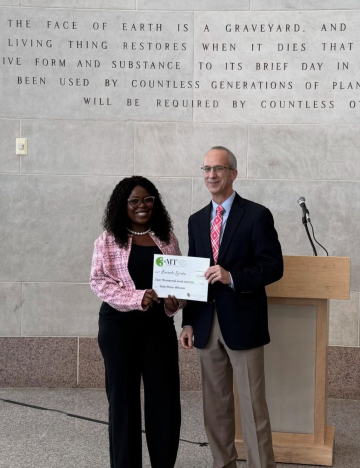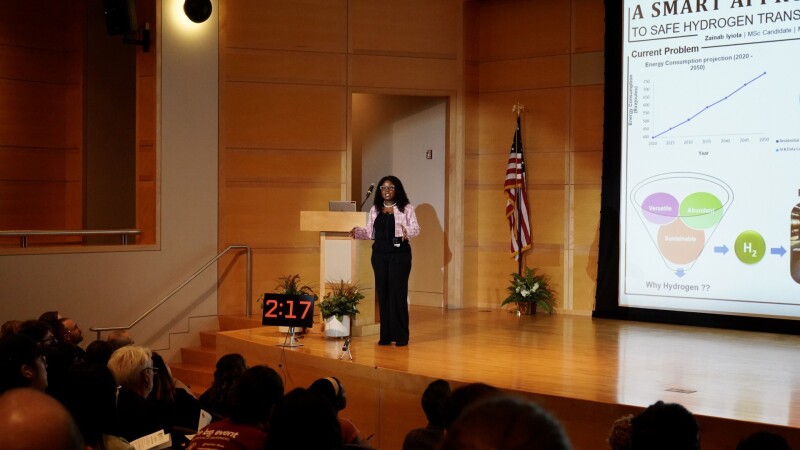Zainab Iyiola, SPE, is a graduate student at the University of Oklahoma (OU), pursuing dual master’s degrees in petroleum engineering and data science. She graduated top of her class from the University of Mines and Technology in Ghana and was selected as a delegate for the 2022 IPTC Education Week in Saudi Arabia.
Her research focuses on hydrogen energy, carbon capture, storage, and utilization, enhanced oil recovery, and machine learning applications in energy. She is passionate about applying technology to solve real-world energy challenges.

She is a recipient of several honors, including the 2024 Egbert Imomoh SPE Scholarship and the African Energy Chamber Scholarship.
In March, Iyiola won OU’s 3-Minute Thesis (3MT) competition, an annual event challenging graduate students to present their research in just 3 minutes to a nonspecialist audience, becoming the first student of OU’s Mewbourne College of Earth and Energy to win the university-wide competition.
Iyiola went on to represent OU at the regional 3MT competition during the 81st Midwestern Association of Graduate Schools Annual Meeting in Indianapolis in April.
TWA: What initially inspired you to enter the 3MT competition?
ZI: I was inspired to enter the 3MT competition by a desire to grow as both a researcher and a communicator. My work focuses on hydrogen pipeline safety, a topic that is technically complex but highly relevant to public safety and the future of energy. I wanted to challenge myself to explain this research in a way that people outside of engineering could understand and care about.
I had seen past 3MT presentations where students used simple language to present powerful ideas, and that motivated me to do the same. I also saw 3MT as an opportunity to raise awareness about a topic of global importance and to bring visibility to research that directly impacts public safety, energy reliability, and infrastructure development. For me, it was a chance to step outside of my comfort zone and engage people who might never otherwise hear about this important area of energy research.
TWA: How did you feel when you found out you were the first student from your school to win the university-wide 3MT competition?
ZI: When I found out that I was the first student from the Mewbourne College of Earth and Energy to win the university-wide 3MT competition, I felt deeply honored and grateful. One of my professors had mentioned early on that no student from our college had ever received the award, and that knowledge became a strong motivator for me. It pushed me to approach my preparation with intention.

I spent time researching effective science communication strategies and worked closely with my professors, Ramadan Ahmed and Deepak Devegowda, to refine the way I conveyed my research. Their guidance helped me distill a technically challenging project into a clear and relatable narrative. Being able to represent my college and share research of global significance in a format that resonated with a general audience was incredibly fulfilling. Winning the competition was not only a personal achievement, but also a meaningful moment for my college, as it highlighted the importance and impact of energy research within a broader academic and public context.
TWA: Can you briefly describe what the 3MT competition is and what makes it such a unique challenge for researchers?
ZI: The 3MT competition is an academic contest that originated at the University of Queensland in 2008 and has since grown into an international event held at more than 900 institutions worldwide. It challenges graduate students to present their research to a nonspecialist audience using only one static slide and within a strict 3-minute time limit.
What makes it such a unique challenge is the balance it requires between depth and simplicity. Researchers must distill complex ideas, often developed over several years, into a clear and compelling narrative that resonates with people outside their field. There is no room for jargon or overly technical explanations. Instead, participants must focus on the core message and explain the real-world impact of their work in a way that is both accurate and engaging. It tests not only communication skills, but also the ability to connect with a wider audience, which is essential for researchers who hope to influence policy, industry, and global conversations.
TWA: The competition requires participants to condense complex research into just 3 minutes. How did you approach that challenge?
ZI: I approached the challenge by first identifying the core message of my research: why it matters, who it benefits, and what problem it solves. Instead of trying to include every technical detail, I focused on the broader purpose and real-world impact. I asked myself what a person without any background in engineering or data science would need to know in order to understand and care about the work. From there, I structured the presentation as a story, with a clear beginning, middle, and end.
I practiced with people outside my field, refined the language based on their feedback, and made sure every word added value. With guidance from my professors Ahmed and Devegowda, I fine-tuned both the content and delivery to make the message clear and engaging. This experience taught me that simplifying a message does not reduce its power. Instead, it makes the message stronger by allowing it to connect with more people.
TWA: What was it like to compete as the only master’s student against a field of PhD candidates?
ZI: The competition had three stages. I first progressed from the preliminary round to the semi-finals, and then advanced to the finals, where I competed alongside nine PhD students. Out of the 10 finalists, I was the only master’s student. It was both humbling and empowering. Standing among researchers who were further along in their academic journeys pushed me to work harder and be more intentional with every part of my presentation. I knew I had a shorter timeline of research experience, but I also believed deeply in the relevance and impact of my work. Rather than seeing it as a disadvantage, I saw it as an opportunity to show that clarity of thought, purpose, and communication can transcend academic levels. Reaching the final and winning as a master’s student affirmed that well-articulated research, no matter the stage, can hold its own on any platform.
TWA: What does this win mean to you personally and professionally?
ZI: This win has been incredibly meaningful to me, both personally and professionally. It reinforced my belief that research should not only be rigorous, but also relatable and relevant to the world around us. Professionally, the recognition has opened new doors. It has strengthened how I present my work in academic settings and has made me even more intentional about public engagement.
On a personal level, it boosted my confidence and reminded me that I belong in spaces where important conversations about science, energy, and public impact are happening.
I am especially excited about the conferences I will be presenting at in fall 2025, where I look forward to sharing my research with a wider audience and continuing to grow as a scholar and communicator. Winning the 3MT competition affirmed my commitment to research that informs policy, improves public safety, and advances the energy sector in meaningful ways.
TWA: What topic did you present during the competition?
ZI: I presented my research titled “A Smart Approach to Safe Hydrogen Transport in Natural Gas Pipelines.” The focus of this work is on developing a model and assessment software designed to evaluate the safety of transporting hydrogen through converted natural gas pipelines.
TWA: Your winning project addresses the critical challenge of hydrogen transport through natural gas pipelines. Can you describe what inspired your research, and explain the significance and impact of the tool you developed?
ZI: My motivation to pursue this research stems from both a technical and societal need. As the global energy mix evolves, hydrogen is being introduced into existing natural gas infrastructure, but this raises serious safety concerns due to hydrogen’s impact on pipeline materials. I became interested in understanding and solving this problem because the consequences of failure in these systems could be catastrophic. This area of research is not only urgent, but also under intense regulatory and industrial scrutiny.

Being selected as a graduate research assistant on a project funded by the US Department of Transportation’s Pipeline and Hazardous Materials Safety Administration (PHMSA) allowed me to directly contribute to a national effort to ensure the safe and reliable integration of hydrogen into the energy grid. My work involves developing a compatibility assessment model that combines fracture mechanics with advanced machine learning to predict how hydrogen environments degrade pipeline materials over time.
As part of this effort, I developed a digital decision-support tool called the Hydrogen Embrittlement Assessment Tool (HEAT). The tool combines machine learning models with physics-based fracture mechanics calculations to evaluate the structural integrity of hydrogen pipelines. It incorporates stress-intensity-factor solutions and simulates fatigue-crack growth, while also using supervised learning algorithms to predict crack-propagation behavior under different hydrogen service conditions. I built the tool’s graphical user interface to allow engineers and decision-makers to perform real-time assessments of pipeline lifetime based on inputs such as pressure range and steel grade. By integrating data science and engineering mechanics, HEAT offers a practical solution for predicting failure risk in hydrogen pipelines with greater precision and accessibility.
TWA: How does your work contribute to the broader goals of energy transition and infrastructure safety?
ZI: My work directly addresses two major priorities at the intersection of energy transition and infrastructure resilience: ensuring the safe integration of hydrogen into existing pipeline systems and supporting the reliability of critical energy infrastructure during that transition. As countries and companies look to diversify their energy sources, hydrogen is being introduced as a cleaner alternative to natural gas. However, repurposing natural gas pipelines for hydrogen service introduces serious risks due to hydrogen-induced material degradation.
The HEAT tool I developed provides a science-based, data-informed framework for evaluating whether existing pipelines can safely transport hydrogen under different service conditions. By integrating fracture mechanics and supervised machine learning, HEAT allows operators, engineers, and regulators to predict failure risk, assess remaining service life, and make informed decisions without requiring destructive testing. This contributes to the safe deployment of hydrogen infrastructure while minimizing the cost and downtime associated with full pipeline replacement.
Ultimately, this research supports energy security, environmental goals, and regulatory compliance by helping to ensure that the backbone of hydrogen delivery (the pipeline network) is both safe and reliable. It equips decision-makers with tools that bridge the gap between emerging energy strategies and practical, field-level implementation.
TWA: What’s next for your research—do you plan to expand on your current project or explore new areas?
ZI: My current focus is on enhancing the HEAT tool by continuously training its machine learning models with new experimental data. As additional results are generated from ongoing tests, the models are updated to improve their accuracy in predicting crack-growth behavior and pipeline lifetime under various hydrogen service conditions. This adaptive learning process strengthens the tool’s ability to reflect real-world performance and extend its reliability across a broader range of materials and loading scenarios.
With the existing framework in place, there is significant potential for further development. The underlying architecture of HEAT can be expanded to address additional challenges in hydrogen infrastructure, including underground hydrogen storage, variable cyclic loading effects, and multi-pressure transmission systems. The model’s flexibility allows it to be scaled and integrated into broader regulatory or industry assessment protocols.


